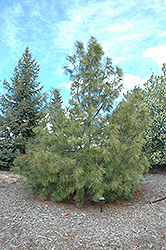Plant Library
Height: 95 feet
Spread: 30 feet
Sunlight:
![]()
Hardiness Zone: 4a
Description:
A stately upright pine with dense branching and soft long green needles; its broad conical habit creates the classical conifer look; a beautiful accent tree for the home landscape
Ornamental Features
Western White Pine is primarily valued in the landscape for its distinctively pyramidal habit of growth. It has attractive green evergreen foliage. The needles are highly ornamental and remain green throughout the winter.
Landscape Attributes
Western White Pine is an evergreen tree with a strong central leader and a distinctive and refined pyramidal form. Its relatively fine texture sets it apart from other landscape plants with less refined foliage.
This is a relatively low maintenance tree. When pruning is necessary, it is recommended to only trim back the new growth of the current season, other than to remove any dieback. It has no significant negative characteristics.
Western White Pine is recommended for the following landscape applications;
- Accent
Planting & Growing
Western White Pine will grow to be about 95 feet tall at maturity, with a spread of 30 feet. It has a high canopy of foliage that sits well above the ground, and should not be planted underneath power lines. As it matures, the lower branches of this tree can be strategically removed to create a high enough canopy to support unobstructed human traffic underneath. It grows at a fast rate, and under ideal conditions can be expected to live for 80 years or more.
This tree should only be grown in full sunlight. It prefers dry to average moisture levels with very well-drained soil, and will often die in standing water. It is considered to be drought-tolerant, and thus makes an ideal choice for xeriscaping or the moisture-conserving landscape. It is not particular as to soil type or pH. It is somewhat tolerant of urban pollution. This species is native to parts of North America.


